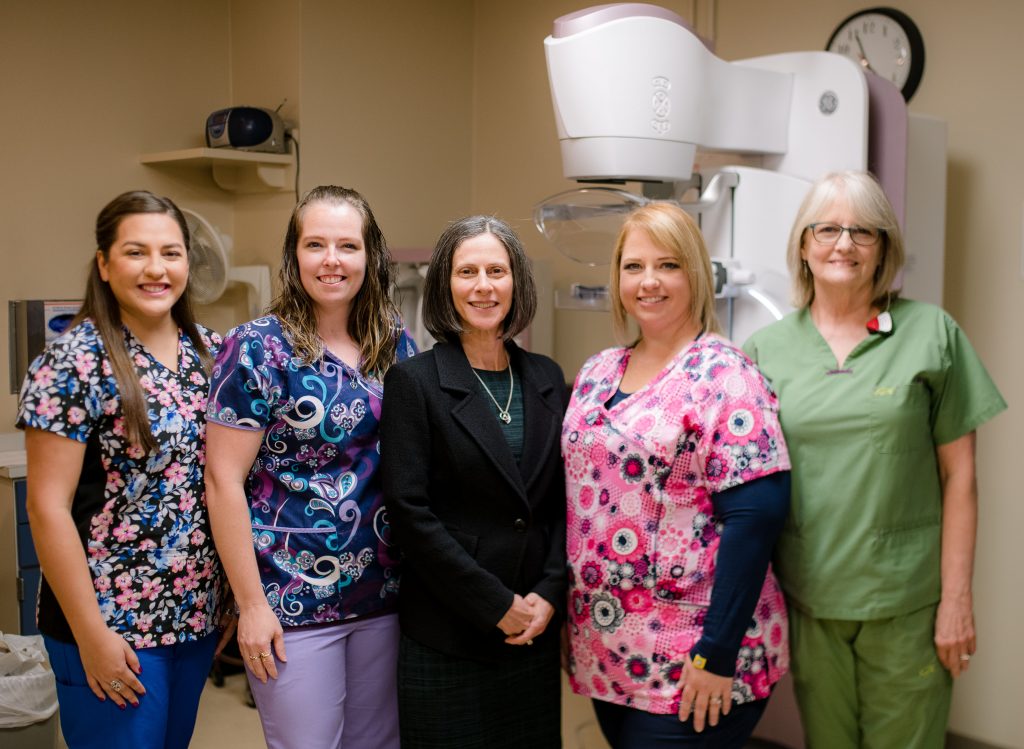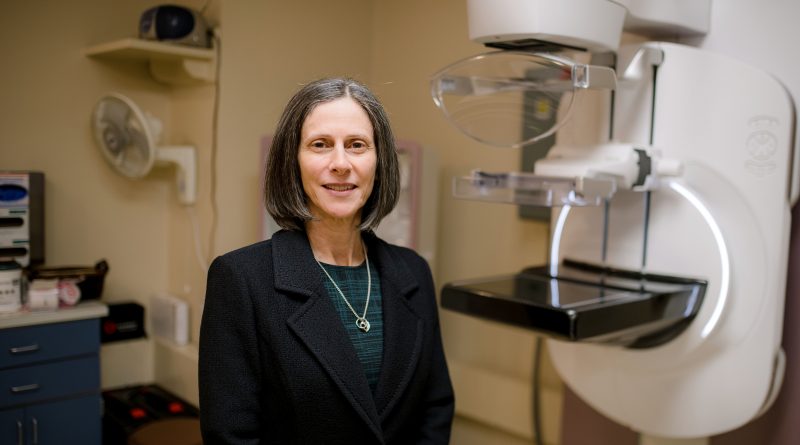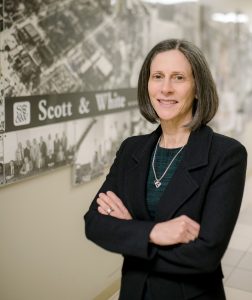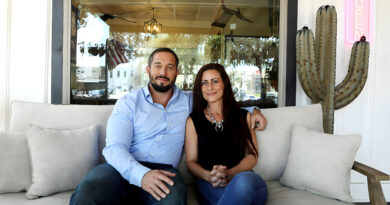Dr. Debra Monticciolo’s Goal: Saving Women’s Lives
By Don Cooper | Photography by Justin Borja
Debra Monticciolo, M.D., is an internationally recognized expert in breast imaging, a researcher, a teacher and a leader with a single goal: save lives with early detection and treatment of breast cancer.
The vice chair for research and the breast imaging section chief in the Radiology Department at Scott & White Medical Center in Temple, Dr. Monticciolo is in the middle of her term as president of the American College of Radiology, an organization with more than 38,000 members.
Her rise to the top of her profession has a humble beginning. Raised in Detroit, her father was a truck driver and her mother was a homemaker. She was a first-generation college student and put herself through medical school.
“I came from a very simple background,” she says. “My father was really a hard worker and a good provider, but I couldn’t do things a lot of other kids could do, like go out of state for school. I had really good grades, but I had to go on scholarships that were offered to me locally. That’s how I got through college. I put myself through medical school.”
With a work ethic inspired by her father, Dr. Monticciolo received her undergraduate and medical degrees from Wayne State University.
After starting in emergency medicine, Dr. Monticciolo became interested in radiology — a move that changed her life and the lives of many others who have benefited from her research and teaching.
“I love my work. Helping patients, especially women, is important to me and extremely rewarding,” she says. “I work with a lot of women with breast cancer and they are a constant inspiration for me. I love to teach; I’ve trained innumerable residents and many, many fellows in breast imaging over the years.”
Dr. Monticciolo and her husband, Bruce Griffing, Ph.D., came to Texas in 2001 because of his work.
“He’s a very, very interesting man,” she says. A retired physicist, he specialized in industrial electronics and ran a research lab for General Electric. “His group built the first digital mammo(graphy) machine. Digital acquisition was his idea. He pitched that idea to (GE chairman and CEO) Jack Welch.”
Dr. Monticciolo and Griffing, who have been married 20 years, met at a conference while she was working at Massachusetts General Hospital in Boston. There was a natural bond. A brilliant physicist and a brilliant medical researcher both interested in a technology that can be used to save lives.
There were lots of opportunities for Dr. Monticciolo in Texas, including a position at M.D. Anderson, one of the world’s foremost cancer research institutions. But she chose Scott & White.
“What drew me here was just the people,” she says. “The radiology department is really strong and they offered me the opportunity to build the breast imaging section. I had built divisions before and liked that opportunity.”
Scott & White also gave her the opportunity to teach. Moreover, her national and international work has been supported.
“I really like being in a position where I’m teaching residents,” she says. “I have good colleagues. They have encouraged a lot of my national committee work. I couldn’t do what I do without the support of my (Department of Radiology) chairman Mark Montgomery, M.D., and my division (diagnostic radiology) chief Travis Sincleair, M.D. They are both extremely supportive of this scholarship work. They know it has an impact on a national level.”
Dr. Monticciolo’s rise to the presidency of the American College of Radiology is the culmination of years of committee work. She was the chair of the commission on breast imaging, which included briefing Congress. She served two terms and chaired the FDA Committee on Mammography Quality.
Her teaching and research have taken Dr. Monticciolo to China, India, Italy, South Korea and Panama. In 1994, when she was division chief at Emory University in Atlanta, she helped install the first modern mammographic imaging equipment in China and then trained physicians on how to use it.
Before a trip to take mammography equipment to India, Dr. Monticciolo recalls an unusual phone conversation.
“They called me about a week before we were going to go and asked me if I could bring clothes pins. Clothes pins?” she asked. “‘We’re going to hand develop the X-Rays’” came the response. “We didn’t learn to do that in residency, but that’s what we did.”
While research, teaching and leadership positions have taken Dr. Monticciolo to the top of her profession, she’s most proud of the help she provides to patients.
“All the little moments with patients stand out to me,” she says. “When you feel like you’ve helped a woman with an early diagnosis or helped somebody survive breast cancer, wow, there’s so much impact there. There’s a lot of sadness too. I see a lot of women come in with advanced disease and I wish we could have gotten to them sooner.
“But to me it’s taking care of patients and feeling like you made a difference.”

Early detection makes a difference
Dr. Debra Monticciolo’s 30 years of experience working with breast cancer treatment teams has helped her realize how important good imaging is for patient care and how critical it is for tumors to be found early. Early detection with mammography can make the difference between a cancer that is treatable and one that is a killer.
Breast cancer is the most common cancer in women, with over 268,000 new cases expected in 2019. Screening mammography saves lives — and can make a big difference in treatment. “I feel like mammography is misunderstood,” Dr. Monticciolo says. “There’s a lot of confusion about it and there shouldn’t be. It is straight forward.”
Women have received mixed messages because of competing agendas. Federal guidelines say women do not need to get screened for breast cancer before age 40 and that annual mammography is not needed.
Dr. Monticciolo says annual screening, especially after age 40, is important. “If you want to save the most mammograms, you follow the government’s recommendations. If you want to save the most lives you do annual screening at 40. It’s really not very complicated … the facts are pretty clear.”
The “negative side” — a “false positive“ — is “overblown,” she says. It happens about 10 percent of the time. “Most women are happy to come back to make sure.”
Dr. Monticciolo urges women to get a quality risk assessment if there’s a family history of breast cancer, but she adds that 75 percent of the women who are diagnosed had no risk factors. She is working on a “scientifically based” toolkit that will provide women with the information they need. “Here are the pluses, here are the minuses so people know and can make their own decisions.”
Debra Monticciolo’s background
- Current President of the American College of Radiology, a national society founded in 1923 and now represents 38,000 radiologists, radiation oncologists, nuclear medicine physicians and medical physicists nationwide.
- Given more than 350 invited lectures nationally and internationally.
- Recognized expert in breast cancer screening and breast MRI.
- Lead author of two recent guideline papers, one on breast cancer screening recommendations for women of average risk and one on breast cancer screening recommendations for women at higher than average risk.
- Founding member of the Screening Leadership Group of the ACR.
- Immediate past chair Commission on Breast Imaging (ACR), which focuses on national issues related to breast imaging and cancer screening.
- Past president of the Society of Breast Imaging.
- 2019 SBI Gold Medal recipient, the society’s highest honor.
- Past Chair of Accreditation and Chair of Mammography Accreditation for ACR — which accredits radiology facilities nationwide.
- Served two terms on the FDA’s National Quality Assurance Advisory Committee, which advises the U.S. Congress on mammography quality.
- Installed first modern mammographic unit in mainland China — 1994; taught there and obtained grant to bring Chinese physician to U.S. for training.
- Participant in mammography projects in India, South Korea and Panama.
- Most recent international lectures were in Italy and China.
- “My husband and I love hiking and travel. We’ve hiked many locations in the U.S, Europe and New Zealand. Our biggest trip was hiking the Inca Trail in Peru.
- “Temple has been a wonderful place to live and work. The town is family-oriented and people are caring and helpful. When I go running in the neighborhood or the nearby park, people are friendly. I love the feeling of community here.”




